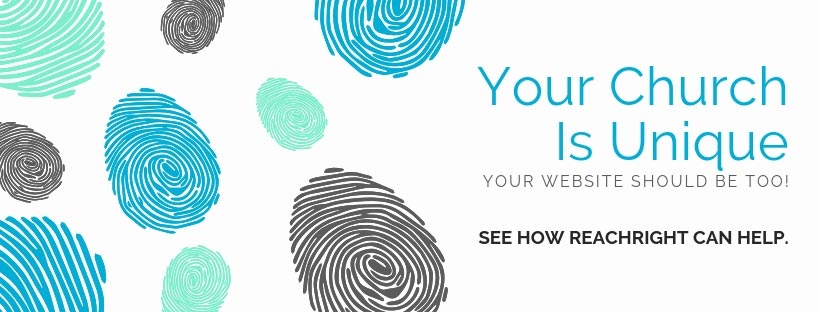You have two main options for creating a church website – hire a web design company for a custom site or go with church website templates.
Both are valid and can work well when done correctly. However, templates sometimes seem too good to be true. Before jumping on the website template bandwagon, it’s a good idea to understand what you’re getting.
Balance the pros and cons to see if it’s better for your church to go custom or with a template.
PRO: Quick And Easy
The most obvious benefit of church website templates is they’re quick and easy to implement. With custom sites, it may take weeks to get up and running.
If your church wants or needs something faster, a template is nearly ready to go from the moment you buy it. All it takes is uploading it to your web host and adding your own content.

In this case, you could be up and running in just a few days. For most churches, there isn’t an urgent need to be online this quick. However, the ease of simply choosing a template and getting your church in from out millions of eyes is definitely tempting.
CON: Looks Like Numerous Other Sites
On the other hand, numerous other churches and businesses also love how quick and easy it is to use templates. You might have noticed something when browsing templates – they can be purchased more than once.
This means even though you love a particular template, it’s not going to be unique to your church. In fact, some website template sites even list the number of downloads, which can be in the thousands.
Even though you’re online faster, it’ll be harder for site visitors to tell your site apart from the hundreds or even thousands of others that are using the exact same template. Everything from the layout to the colors used could be the same.
If you want your church’s website to truly stand out from the competition and make the vital great first impression, a custom site is always the way to go. Remember, it takes 50 milliseconds or less for visitors to form an opinion. Make sure it’s going to be a good one.
PRO: Costs Much Less
Small churches, especially, will love the cost of church website templates. Since they only need to be developed once and sold many times, they’re far cheaper than custom websites.
In fact, many templates are less than $100. Of course, this doesn’t include the cost of hosting. If you’re not sure if a website is the right strategy for your church, using a template is a cost effective way to test the waters first.
Some churches start with a template and once they start seeing growth, they upgrade to a custom site to better engage visitors. It’s an effective strategy and also gives you insight into everything that is involved in maintaining a site.
CON: May Not Look As Professional
Many modern church website templates do look more professional than their older counterparts. However, seeing the exact same look on hundreds of other websites makes your church’s site seem less professional.
Think of it as the difference between having your own domain name and being stuck with a sub-domain name. The first would be yourchurch.com, while a sub-domain might be yourchurch.somedomain.com. If you had to pick between the two, you’d see the first option as more professional.

The same is true with your site’s layout. If it’s unique to you, it looks more professional than a clone of other sites.
PRO: Offers Most Of The Basics
Most church website templates offer all the basics you need to set up a presence online. This includes the essential pages, such as a home page, about page and blog.
Some also include sections to accept payments for online tithing or selling goods online, such as custom crafts to raise money.
Without so many different features, it’s easier to fill in the content and move on. In most cases, you can remove features and pages you don’t need to customize the template a little.
CON: One-Size Doesn’t Fit All
As you may have noticed, we said templates offer the basics. What if you want or need more than that? Church website templates are like one-size-fits-all shirts. Yes, the shirts may technically fit, but they don’t always look great.
Just like people, churches come in a variety of shapes and sizes. A one-size-fits-all option won’t always work. You may need additional features or a more extensive footer. Perhaps you want to move elements around to offer a better user experience and keep visitors more engaged.
Templates are great, but only if they fit your needs, which may not always happen.
PRO: Plenty Of Options To Choose From
Website templates are a huge business. This means you’ll find numerous options to choose from. It’s easy to quickly find thousands of church website templates across several marketplaces.
Of course, this variety can also be a problem. You could spend days just digging through your options to find what works best for your church.
To make this easier, have an idea of what you want your site to look like before you start your search. Then, when you see something close to what you envisioned, your search is over.
CON: Can Be Difficult To Update Or Change
Variety is great, because church website templates may be difficult to update or change. Instead of trying to dig through the code and make changes, many people just buy a new template that better fits their changing needs.
Plus, templates typically come as a package deal. You get certain widgets and other features that may need frequent updates to keep your church’s site more secure. Once a designer has developed this template package, they may not do anything else to keep it updated.
This leaves you having to try to make updates manually or buying something new and transferring your content to the new template. This process can be time consuming and may result in broken links and other issues that cause your site’s rank to plummet. You can hire someone to do this for you, but it’s usually cheaper to just go with a custom site versus paying someone to fix your template issues after the fact.
PRO: See A Demo Before You Buy
When working with web developers and designers, you get to see wireframes and in-progress demos as your site’s developed. With church website templates, you get to see what your site will look like before investing anything.

Most templates have a demo version to let you explore the site before you buy. It’s important to note that this doesn’t always include a demo of the backend, which is where you’ll manage the site. For WordPress templates, the backend pretty much always looks the same. For other platforms, backends may vary greatly.
If you’re concerned about ease of management (which you should be), ensure you pick templates that give you a demo of the front and backend to better understand how the site works.
CON: Doesn’t Always Integrate Well
Do you have certain plugins and services in mind to use with your church’s site? This isn’t always possible with templates. Many of them are designed to only work with very specific services and plugins.
This means you may be limited to how many different payment options you can use for your online tithing feature. You might only be able to use one or two different email management services, which may not be the ones you prefer.
Always check the integration possibilities before investing in a template.
PRO: Looks Straightforward
It’s hard to deny how straightforward templates look. Plus, you have that incredibly enticing demo that makes it seem like anyone could jump right in and be an expert web master.
Church website templates are made to make the process seem and feel as simple as possible. They help eliminate the entry barrier when it comes to going from website user to website owner.
By keeping everything simple and straightforward, they’re much more appealing. But, looks can be deceiving.
CON: Often Difficult To Manage
As straightforward as templates often look, they’re not always easy to manage. Yes, using the site is easy. Navigation is simple for visitors and it’s obvious where you need to add content.
However, actually managing the backend is often an exercise in frustration. It’s either so simplistic that you can’t make the changes you want or it’s so complex that you’ll spend hours just figuring out how to edit a few text boxes or change the background colors.
Of course, this doesn’t even include how difficult it may be to install updates or connect to third-party services. Management is a large part of owning a website. Once again, opt for demos that show the management side of the template before buying.
PRO: Less Customization (Good For Beginners)
At first, this might seem like more of a con, but if you’re a beginner who’s trying to get a church website up and running quickly, less customization is a major benefit.

For instance, do you want to have to dig through dozens of menus to customize fonts, colors, backgrounds, button types and more? Or, would you rather have a quick checklist of basic options to choose from?
Church website templates keep customization simple and easy so all skill levels are able to add some basic customization without feeling overwhelmed.
CON: Limited Customization
On the other hand, limited customization means your church website is going to look even more like every single other site using that same template. For those who aren’t afraid to get their hands dirty, having your options limited can be annoying. After all, you bought the template and you should be able to change it if you want, right?
Depending on the template you bought, you actually may be able to dive in and change as much as you want. This requires you to be comfortable with at least HTML and CSS.
From here, you can change most everything about the layout and design aspects. It’s still difficult to make more advanced coding changes without a development background, but it’s possible.
If you do start digging around in the code, ensure you have a backup of your site. Otherwise, that easy to use template could turn into a disaster that you can’t even use anymore.
PRO: Some Can Be Custom Built
If you’re willing to pay a little more, which can be anywhere from $50 to several hundred, you can get custom built church website templates. You pick a base template and request the changes you need. This could be adding new pages, adjusting the layout or ensuring it’ll integrate with a certain service.
The more customizations you want, the more it’ll cost. Depending on how much work you need done, it’s sometimes cheaper and easier to start with a custom site to begin with versus trying to completely re-work a template.
Remember, templates are made to help you avoid customization and longer development times. Custom built templates can take just as long to finish as custom sites.
CON: Less Secure
Remember how we talked about how templates aren’t always maintained or updated after they’re put up for sale? Cybercriminals love website templates, whether it’s a church, business or personal website. Why? They’re less secure and you only need to know how to hack one to hack every site using that template.
Part of the benefits of a custom site is they’re better maintained with better security built in. Sadly, hackers don’t care whether they ruin your church’s site and online reputation.
If security is a priority, and it definitely should be, ensure you’re using a template that comes with updates and support. Otherwise, you could be taking a major risk. This is especially true if your church site uses logins for visitors or accepts payment information.
However, even with a custom site, you will need to have a maintenance schedule in place for optimal security. This includes handling updates, removing outdated plugins and restricting user access to the backend.
Want a church website that perfectly fits the needs and goals of your growing church? Contact us today to learn about developing a custom church website.




